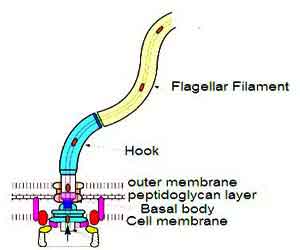The hair-like extended portion of the cell surface bounded by the cell membrane and containing microtubules and responsible for cell motility are known as cilia and flagella. The cilia and flagella are widely distributed in both the animal and plant cells.
Flagella (singular = flagellum) are complex filamentous, long, thread-like structures that extend from the plasma membrane. They are un-branched, mostly composed of the protein flagellin. The cell contains one or a few flagella, which are primarily used for locomotion. They protrude from the body of the cell and perform their functions effectively. Flagella are longer in size, which grows up to 150 um in length. Flagella are found in both prokaryotic and eukaryotic cell and serve the same functions in both types of cells but are structurally different. The majority of bacteria possess flagella that are used for locomotion.
Cilium (cilia=plural) is a hair-like microscopic structure. It originates from cell surface of many eukaryotic cells. It is a membrane-bound structure which can grow up to 20 µm in length. It can perform to move entire cells. It can also move various substances around cells.
For examples, cilia of the fallopian tubes help to move the ovum towards the uterus and cilia of the respiratory tract move particulate matter toward the throat.
Where Found
Cilia are found in:
- Paramacium
- Flame cells (flatworms)
- It is also found in various larvae of invertebrates such as Bipinnaria, Trochophore, tornaria, Amphilinidea larva, etc.
- Epithelial cells of respiratory tract;
- Fallopian tube;
- Sperms of fern
- Renal tubules
- Sperms of Cycas
- Various types of gametes (such as slime molds, fungi, and animals, etc).
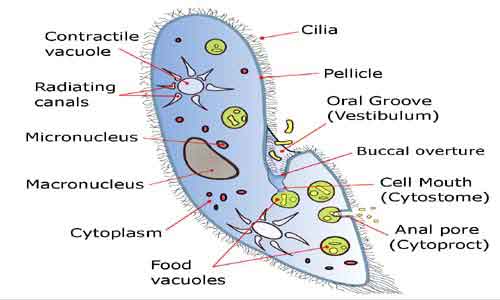
Paramacium Shows Cilia
Flagella are found in:
- Euglena, Clamydomonas, Phacus (protozoans), etc.
- Sponge`s choanocyte cells
- Cnidarian gastrodermal cells;
- Animal sperms.
- Plants sperms such as bryophytes and pteridophytes
- Many algal gametes, etc.
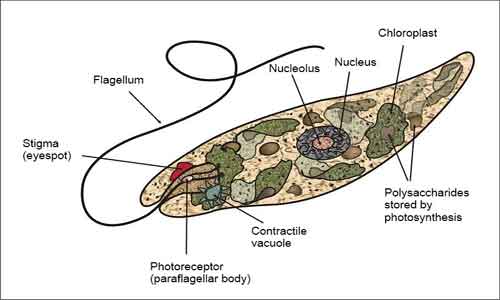
Euglena shows Flagellum
Parts of Ciliary Apparatus
The ciliary apparatus is composed of the following parts:
The shaft: It originates from the cell surface and form the slender cylindrical process. It lies external to the cell. In cilia, it is short (3-10 µm), but in flagella, it is longer (up to 150 µm). The axis of cilium consists of 2 central microtubules surrounded by nine pairs of microtubules (9+2) pattern), which is embedded in the ciliary matrix. It is covered by the ciliary membrane, which is the extension of the cell membrane. The basic microtubular framework, i.e., the axis of cilia and flagella, is called axoneme.
The basal body or granule: The basal body or granule is a centriole-like cellular organelle that is arranged in rows beneath the cell membrane. From this, the body of the cilium originates. The basal body is also known as kinestosome.
Basal Plate: Its structure look-like plate which is placed between the shaft and the body. The development of central singlet fibrils occur in this region.
The ciliary rootlets: The ciliary rootlets originate from the basal body. They unite to form conical bundles.
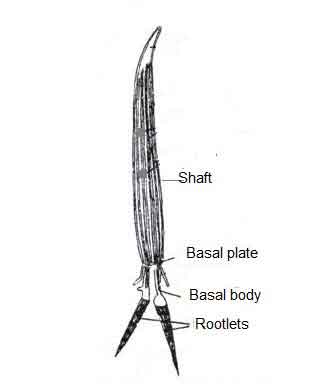
Structure and Parts of a Flagellum
Cilia and Flagella Types
There are two types of cilia: (1) kinocilia and (2) Stericilia. In this case, kinocilia type cilia are motile that contain axonema while steriocilia type cilia are non-motile which do not contain axonema.
Besides these, Flagella are also of two types: (1) Tinsel flagellum and (2) Whiplash flagellum. In this case, the tinsel flagellum contains hairy outgrowths known as mastigonemes. On the other hand, whiplash flagellum does not contain any hair-like outgrowth.
Bacterial Flagella
In the bacterial cell, the following four types of flagella are found:
Monotrichous: This type of flagellum is found in Vibrio cholera.
Amphitrichous. This flagellum is found in Alkaligens faecalis. It originates from both ends of the bacterium body.
Lophotrichous: They originate from one or both sides of the bacterium body, such as Spirillum.
Peritrichous: They originate from all over the bacterial body and numerous in numbers such as Salmonella Typhi.
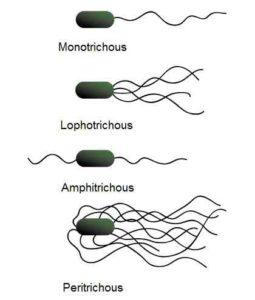
Bacteria showing flagella
Functions of Cilia and Flagella
- Flagellum acts as the locomotory organs in many algae and other protists.
- In the aquatic medium, the flagellum of many organisms helps to capture food particles.
- Flagellum circulates food in the gastro-vascular cavity in coelenterates or spongocoel (choanocytes) in sponges.
- The cilia makes the lining in the cells of the respiratory tract. It can eliminate dust or solid substances from the respiratory tract.
- In many aquatic organisms, cilia can create water current to receive oxygen (O2) and quick remove of CO2.
- Cilia perform many essential tasks. Among them tasks, it can do passageway of eggs in the oviduct. It can also help passageway of excretory products in the kidneys, etc.
- In many cases, both cilia and flagella execute various sensory functions. In this case, they show sensation to changes in temperature, light, contact, etc.
Difference Between Cilia and Flagella
|
Cillia |
Flagella |
|---|---|
|
Cilia are numerous in number. |
Flagella are less (usually 1-2) in number. |
|
Cilia may occur throughout the surface of the cell. |
Flagella occur at one end of the cell. |
|
The cilia are shorter in length(5-20µ). |
The flagella are longer in size(150µ). |
|
The movement of cilia takes place in coordinated rhythm. |
Flagella move independently. |
|
Cilia move in a sweeping or pendular stroke. |
Flagella exhibit undulatory motion. |
|
In cross section, Nexin arm is present. |
In this case, Nexin arm is absent. |
|
It is found in eukaryotic cells. |
It is found in both eukaryotic and prokaryotic cell. |
|
For performing the movement, they use kinesin which has an ATPase activity that produces energy. |
Flagella perform functions powered by proton-motive force by the plasma membrane. |
|
Cilia help in locomotion, feeding, aeration, etc. |
It helps only in locomotion. |

